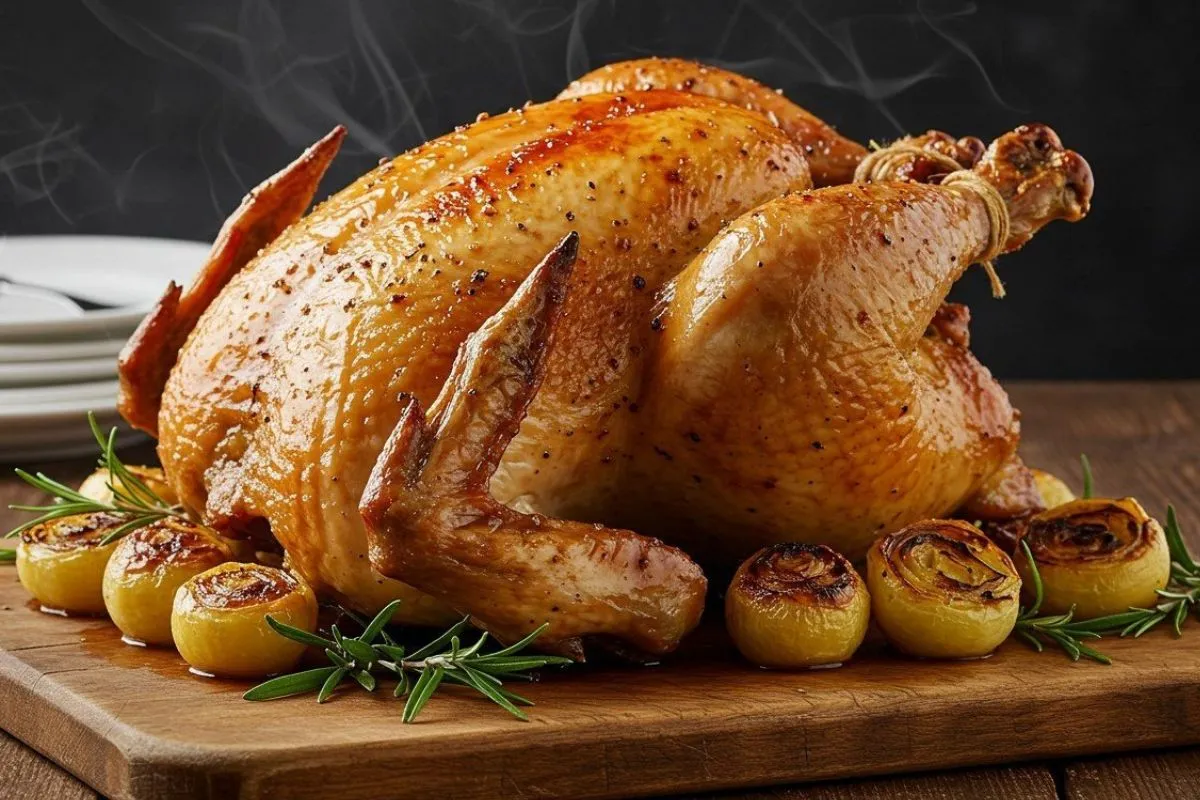Imagine slicing into a perfectly roasted chicken and watching the juices flow, each bite bursting with savory goodness. If you’ve ever struggled with dry, lackluster poultry, you’re in for a delicious surprise—Chicken Brine is here to save the day. Brining chicken before roasting, grilling, or frying is one of the best-kept secrets for ultra-tender meat you’ll want to serve at every special gathering (or just because). In this comprehensive guide, you’ll learn what a chicken brine does, how to make it, and how to adapt this technique to fit your favorite cuts of poultry. Get ready to level up your roasting game and transform any average chicken dinner into an unforgettable feast!
Table of Contents
Why Chicken Brine Works
When you hear “Chicken Brine,” think of it as the ultimate moisture-locking solution. Brining relies on osmosis, a natural process where salt pulls water and seasonings into the chicken. In practical terms:
- Moisture Retention: Salt partially dissolves the chicken’s muscle fibers, allowing the meat to hold onto more water.
- Enhanced Flavor: The salt water not only plumps up the meat but infuses it with subtle seasoning all the way to the core.
- Tender Texture: With the proteins relaxed, the chicken becomes noticeably softer and more tender, even if you accidentally cook it a little longer than planned.
In short, using a chicken brine can dramatically elevate the taste and texture of your dish, turning a standard bird into a showstopper.
What Does Brined Chicken Taste Like?
Brined chicken is renowned for its tenderness and succulence. Here’s what you can expect:
- More Juicy: With extra moisture locked in, each slice of brined chicken bursts with natural juices.
- Slightly Salty: The salt level is balanced, not overwhelming, especially when you follow recommended brine times.
- Enhanced Seasoning: Any herbs, spices, or aromatics used in the chicken brine will subtly weave through the entire piece of meat.
If you’ve ever experienced bland chicken, rest assured, brined chicken is anything but dull. Each bite is packed with flavor—without the need for excessive sauces or additional seasoning.
Ingredients for the Perfect Chicken Brine
A high-quality chicken brine doesn’t have to be complicated. Here is a simple list of the essentials you will need:

- Water (enough to fully submerge your chicken)
- Salt (coarse kosher salt is often preferred, but table salt also works in precise amounts)
- Sugar (optional, helps balance the saltiness and aids browning)
- Herbs & Spices (such as rosemary, thyme, bay leaves, peppercorns)
- Aromatics (like garlic, onion, citrus peels, or chili flakes, based on preference)
Experiment with different herbs, spices, or even a splash of citrus to customize your chicken brine. Some people like to include sweeter elements like honey or maple syrup for a unique flavor twist.
Step-by-Step Directions
- Measure Your Ingredients: Aim for about ¼ cup of salt per quart (4 cups) of water. Adjust amounts if you’re brining a larger bird.
- Dissolve the Salt and Sugar: Warm a portion of the water in a pot and stir in the salt (and sugar, if using) until fully dissolved.
- Add Flavorings: Throw in fresh herbs, crushed garlic, peppercorns, or citrus. Bring the mixture to a gentle simmer, then take it off the heat.
- Cool Completely: Add the remaining cold water or ice cubes. The brine must be fully cooled before adding chicken to avoid partially cooking the meat.
- Put the chicken in a non-reactive container or a large zip-top bag, making sure it’s completely submerged. Pour the brine over the meat, making sure it is fully covered.
- Place the chicken in the fridge and let it brine for the recommended duration.
- After brining, rinse the chicken under cold water to eliminate excess salt, then gently pat it dry.
Pat dry with paper towels before cooking.

Cook’s Note
- For a lighter salt taste, reduce the brine time or use slightly less salt.
- If you’re pressed for time, you can brine at room temperature for about 1 hour, but make sure the brine is cold and keep an eye on the poultry’s temperature for safety.
- Use coarse kosher salt if possible. Fine table salt is stronger by volume, so you’ll use less.
Brine Times Table
Below is a handy table that outlines typical brine times for different chicken cuts. Remember, these are guidelines: the exact duration can vary based on your taste preferences and the salt concentration of your chicken brine.
| Chicken Cut | Approx. Weight | Brine Time |
|---|---|---|
| Whole Chicken | 3–4 lb (1.3–1.8kg) | 8–12 hours |
| Bone-In Chicken Breast | 6–8 oz each | 2–4 hours |
| Boneless Chicken Breast | 4–6 oz each | 1–2 hours |
| Chicken Thighs | 4–6 oz each | 2–4 hours |
| Chicken Drumsticks | ~4 oz each | 2–4 hours |
How to Brine Chicken: Expert Tips
Brining is straightforward, but a few key tips can guarantee success:
- Don’t Over-Brine: Too much time in a chicken brine can lead to overly salty meat or a spongy texture.
- Season After Brining: You may not need additional salt for the final cook. Taste or test a small piece first.
- Keep It Cold: Food safety is paramount; always store your chicken in the fridge while it’s in the brine.
- Use a Reliable Container: Glass, ceramic, or a large, BPA-free plastic bag are excellent options that won’t react to the salt.
The Juiciest Chicken Breast EVER
If you’ve ever struggled with dry chicken breast, brining is your new best friend. Boneless, skinless breasts are notorious for losing moisture quickly, but a short soak in a chicken brine can keep them plump and tender. Even if you’re grilling or pan-searing, that initial brine step can be the difference between a meal that wows and one that disappoints.
Difference Between Brining and Marinating
It’s easy to confuse a chicken brine with a marinade, but they serve different purposes:
- Salt vs. Acid: A brine relies mainly on salt, while a marinade often includes acids like vinegar or citrus.
- Moisture vs. Flavor Focus: Brining emphasizes moisture retention, whereas marinating typically infuses stronger, sometimes tangy flavors.
- Timing: You can marinate for as little as 30 minutes or up to a day, but brining times usually range from 1 hour to 12 hours, depending on the chicken cut.
Both techniques can elevate your dish. However, when pure, juicy tenderness is your goal, a chicken brine is tough to beat.
Can You Use This for Other Meats?
Absolutely! Chicken Brine principles apply to turkey, pork chops, and even some cuts of beef. For instance, a quick brine can be the secret weapon behind slow-cooked beef cheeks—locking in moisture for hours of simmering (check out this mouthwatering dish here: Beef Shank for Tender, Flavorful Dishes. The concept remains the same: use salt to draw in liquid, creating a more succulent final product. Just remember to adjust brine times for thicker or denser meats.
Serving Suggestions
Once your chicken is perfectly brined and cooked, the next question is: “What’s on the side?” There are plenty of delicious options to choose from, including comforting carb-rich sides and lighter, fresher salads.
Watch How to Make It
If you learn best by watching, many culinary experts Experts like Chef J. Kenji López-Alt from Serious Eats have showcased the magic of brining in their videos. Seeing the step-by-step process in action can make you feel more confident. Keep an eye out for reputable cooking channels and blogs that showcase the entire chicken brine process in just a few minutes.
FAQs
How long should I brine chicken?
Brining times vary by the cut and salt level. Smaller pieces need 1–2 hours, while a whole bird usually requires 8–12 hours in a chicken brine. Exceeding the recommended time risks overly salty or mushy meat.
What is the formula for brine?
A commonly used chicken brine ratio is 1 cup of salt per gallon of water. Some cooks add sugar at half the salt amount for balanced flavor. Adjust the ratio to fit your taste or reduce overall sodium.
What is a chicken brine?
A chicken brine is a salt-and-water solution designed to keep poultry moist. Salt draws water into the meat, enhancing juiciness. Using a chicken brine also adds subtle seasoning to every bite.
What is the rule for brine?
Always use enough salt to season and enough water to fully immerse the chicken. Keep your chicken brine cold in the fridge, and don’t exceed the suggested brining time.This guarantees a consistently juicy and flavorful outcome with every try.
More Recipes to Love
- Easy Nachos Chicken Bread Recipe
- The Best Vegetable Beef Soup Recipe for Busy Weeknights
- Taco Soup Frios Recipe Bold Flavors Made Simple
At its core, chicken brine is a straightforward technique that can truly revolutionize your cooking. By brine chicken in a flavorful salt solution, you significantly enhance juiciness and tenderness—ensuring your dinner table is filled with compliments and happy tummies. Whether you’re roasting a holiday bird or whipping up a quick midweek meal, this method is your secret to succulent success. So gather your ingredients, plan your brine times, and elevate your next chicken dish to masterpiece status. Don’t forget to share your brining experiences with friends and family—you might just spark a new culinary tradition.

How to Brine Chicken: Simple Tips for Perfectly Juicy Results!
Ingredients
- 4 cups water
- 1/4 cup kosher salt
- 1/4 cup brown sugar
- 1 tablespoon black peppercorns
- 3-4 garlic cloves, crushed
- 2-3 sprigs of fresh thyme (or 1 teaspoon dried thyme)
- 1 bay leaf
- Optional: 1/4 cup apple cider vinegar or juice of 1 lemon
Instructions
- Make the Brine: In a large pot, combine the water, kosher salt, and brown sugar. Heat over medium heat, stirring until the salt and sugar dissolve completely.Add Flavorings: Add the black peppercorns, garlic, thyme, and bay leaf to the pot. If desired, add apple cider vinegar or lemon juice. Allow the mixture to simmer, then remove from heat.Chill the Brine: Let the brine cool to room temperature. To speed up the process, add ice cubes or cold water.Brine the Chicken: Place your chicken in a large, resealable plastic bag or container. Pour the cooled brine over the chicken, ensuring it’s fully submerged. Seal the bag or cover the container.Refrigerate: Brine the chicken in the refrigerator for at least 1 hour, ideally 4-6 hours. For larger cuts or whole chickens, brining overnight (up to 12 hours) is recommended.Rinse and Dry: After brining, remove the chicken, rinse under cold water, and pat dry with paper towels before cooking.
Notes
- Don’t Over-Brine: Stick to recommended brining times to avoid overly salty chicken.
- Customize Flavors: Experiment with different herbs, spices, and flavorings for unique variations.
- Use a Food-Safe Container: Ensure the container or bag is food-safe to prevent contamination.
- Refrigerate During Brining: Always brine chicken in the fridge to maintain safe temperatures.


Loved how juicy and flavorful the chicken turned out! ⭐⭐⭐⭐⭐